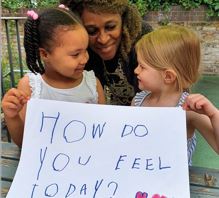50 Fantastic Ideas to Encourage Diversity and Inclusion
June 23rd 2022
When we started to think about writing a book on diversity, Nausheen and I agreed that inclusion begins from the premise that if you build an inclusive approach you will encourage diversity. That means making inclusion “the way we do things around here”, not tokenistic efforts to align with festivals or celebration but having the values of inclusivity embedded at every level of the organisation. Working with small children is a perfect place to begin to examine what is meant by inclusion and diversity. Children are keen to learn and quick to model and role play what they see happening around them. That means they can learn good behaviour as quickly as poor behaviour. This puts pressure on all of us working in the Early Years to have a clear understanding of what inclusion means for us, and how it is translated into a service that encourages diversity of people, ideas experiences and opportunities.

Many people are worried by the concept of inclusion and diversity and often think of it in terms of race and gender but inclusion is much wider and deeper than that. It is an attitude of welcome and openness and a willingness not to judge on surface issues. It means not being fearful of the unknown but looking at things in a way that is honest and intelligent. In fact, showing the same willingness as the children to embrace new and unknown experiences and situations. What we know is that without an ethic of inclusion it is easier for settings and the educational ecosystems to become unhealthy and harbour issues of power and marginalisation and exclusion. For example, the reason LEYF is a social enterprise is to ensure we can support children from disadvantaged families and communities who are often the first group to be marginalised and excluded from accessing quality Early Years education and care.
In terms of inclusion, it means thinking firstly about structural fairness such as fees, available hours, where you operate nurseries, the food you serve, the willingness to support children with SEND. It surprises me that even now in 2022, parents still tell us we are the first setting to agree to take their child with additional learning or medical needs.
When it comes to practice, it is not about having a festival event but translating your own values of inclusion that often align with your context. For example, sometimes we hear people say they have no black dolls or books with black children because there are no black families in the area. There are similar arguments for children with disabilities or families where there are two Mums or two Dads but that is to miss the point and fail to recognise that we are preparing our children to become global citizens, with inclusive attitudes that allow them to be open and welcoming to all new experiences in the future.
Our book provides a large range of regular nursery activities that are underpinned by the values of inclusion. Like anything, when you understand clearly what you are intending to teach, the message can be interwoven and powerful without saying much at all. Whether you are baking a pomegranate cake and opening up a conversation about another country to exploring yourself through a fingerprint activity, painting feelings or developing a parent support network, all these activities build inclusion when they are understood by adults as ways of including and involving children and their families. Activities that are designed for a wider conversation and may be seen as more radical include Drag Queen Storytime or taking part in Pride. These opportunities may need more thought in terms of communicating your intent with parents, staff and children. Having done all of these activities, we were humbled by the thoughtful and empathetic responses they elicited.
The United Nations 17 Sustainable Development Goals (2015) identified SDG4 as ‘Ensure inclusive and equitable quality education and promote lifelong learning opportunities for all’. It’s an admirable ambition and introduces lifelong learning. This is critical in our world of Early Years because many staff working in the sector have not had the opportunities to learn and deeply feel the lack of status and sense of exclusion from the wider educational system.
Creating an inclusive environment means we pay attention to the children but we also pay attention to staff. How do we make staff feel? How do we reward them? How do we campaign for their rights as teachers? Is our attraction, recruitment and retention approach inclusive? Do we think about how and where we advertise? For example, when we were building a campaign to support more men into childcare we discovered we needed to think about where we advertised, the language we used and the images we used on posters and ads. It is often forgotten that working with small children is highly political and Inclusion is falls into this big political agenda especially when you consider inclusion to build diversity is essential for peace, tolerance, human fulfilment, and sustainable development.
50 Fantastic Ideas to Encourage Diversity and Inclusion is available to purchase on Amazon.